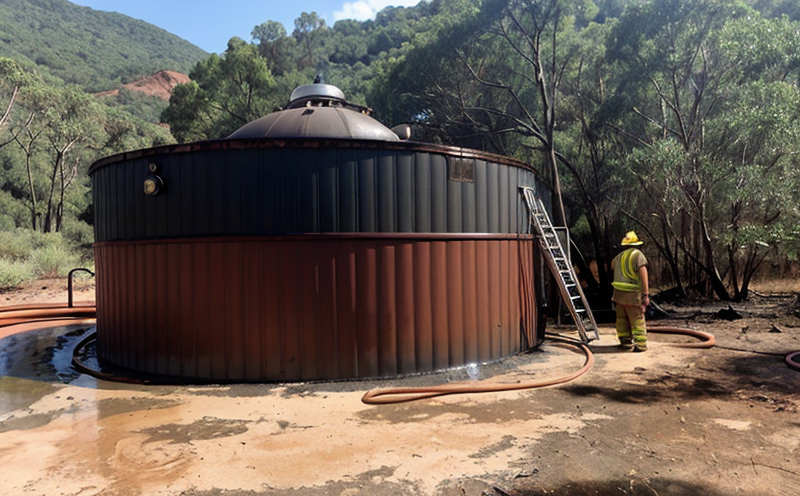Fire water tank inspection
In fire safety and protection systems, fire water tanks play a critical role in ensuring that sufficient firefighting water is available during emergencies. A fire water tank inspection involves thorough evaluation to guarantee the tank's integrity, functionality, and compliance with relevant international standards such as ISO 7056, which specifies requirements for fire water tanks.
Fire water tanks are essential components of fire protection systems in various sectors including commercial buildings, industrial facilities, and high-rise residential structures. Proper maintenance and inspection ensure the reliability of these systems during critical moments when firefighters depend on them to combat fires effectively. The inspection process typically includes visual checks for external damage or corrosion, internal inspections using cameras, and pressure testing to confirm the tank's structural integrity.
The importance of fire water tanks in emergency scenarios cannot be overstated. During a fire, these tanks provide a continuous supply of water to hydrants and sprinkler systems, which are vital for extinguishing flames and preventing further spread. An inspection ensures that all parts of the system work together seamlessly when required. This service is particularly crucial for facilities with large water storage requirements as mandated by local building codes.
Our team of experts conducts comprehensive inspections using advanced non-destructive testing (NDT) methods to identify potential issues before they escalate into larger problems. These inspections not only help maintain compliance but also extend the lifespan of fire water tanks, reducing long-term costs associated with replacements or repairs.
The significance of regular inspections extends beyond mere maintenance; it contributes significantly to overall fire safety strategies within an organization. By identifying and addressing deficiencies early on, organizations can enhance their emergency preparedness plans while minimizing risks posed by faulty equipment. This proactive approach aligns well with broader sustainability goals by promoting resource efficiency through optimized use of critical infrastructure elements like fire water tanks.
For quality managers responsible for overseeing compliance requirements across multiple locations or departments, ensuring that all necessary inspections are performed according to industry best practices is paramount. Compliance officers must be aware of evolving regulations related to fire safety and understand how they impact specific aspects of their operations. R&D engineers involved in designing new systems can benefit from insights gained during inspections since they provide real-world data on performance under various conditions.
Given the critical nature of fire water tanks, it is essential that procurement departments prioritize suppliers who offer reliable products along with robust after-sales support services. By selecting reputable vendors for these important components, organizations ensure that their investments in fire safety measures are protected against unforeseen failures or breakdowns.
Why It Matters
The reliability and performance of fire water tanks directly affect the effectiveness of firefighting efforts during emergencies. Ensuring proper maintenance through regular inspections helps prevent costly downtime, potential injuries, and even loss of life due to inadequate resources when needed most.
From a business perspective, maintaining compliance with relevant standards protects organizations from legal repercussions and financial penalties associated with non-conformance. It also enhances reputation among stakeholders by demonstrating commitment to public safety and environmental responsibility.
In terms of operational efficiency, well-maintained fire water tanks contribute to smoother operations during drills or actual incidents without disrupting business continuity. This translates into reduced recovery times and lower overall costs related to disruptions caused by unexpected failures in critical infrastructure components.
Scope and Methodology
The scope of our fire water tank inspection service encompasses a detailed examination of both internal and external aspects of the tank, ensuring that all elements function correctly as designed. Our methodology involves several key steps:
- Visual Inspection: We conduct an initial visual assessment to identify any visible signs of wear, corrosion, or damage.
- Closed Circuit Television (CCTV): Utilizing advanced CCTV technology allows us to inspect areas inaccessible via traditional means. This provides a comprehensive view inside the tank without causing any physical harm.
- Pressure Testing: To test the structural integrity of the tank, we perform pressure tests under controlled conditions. This helps detect leaks or weaknesses that might not be apparent otherwise.
- Thermal Imaging: Using thermal cameras enables us to identify discrepancies in temperature distribution within and around the tank, which could indicate hidden issues such as insulation failures or water flow problems.
Our approach ensures a thorough evaluation of each component while adhering strictly to internationally recognized standards like ISO 7056. By following this rigorous process, we provide clients with peace of mind knowing that their fire safety systems are in optimal condition at all times.
Competitive Advantage and Market Impact
The demand for reliable fire water tank inspections is increasing as organizations recognize the importance of robust emergency preparedness measures. Our service offers several competitive advantages:
- Comprehensive Coverage: We cover all aspects of fire water tanks, from routine maintenance to complex repairs and replacements.
- Expertise: Leveraging our team's extensive experience in fire safety systems allows us to offer high-quality inspections tailored specifically for your facility.
- Efficiency: By streamlining the inspection process using cutting-edge technology, we minimize downtime and maximize productivity during scheduled maintenance windows.
- Cost-Effectiveness: Preventive measures are more cost-effective than reactive solutions. Regular inspections help catch small problems before they become major issues requiring expensive interventions.
Our service has a significant positive impact on the market by promoting best practices in fire safety and protection systems. By setting benchmarks for excellence, we contribute to safer environments across industries, ultimately benefiting society as a whole.





